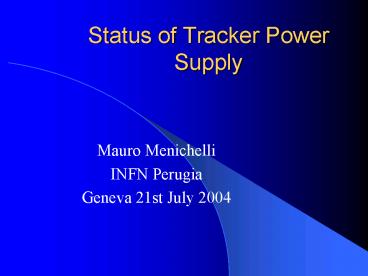Status of Tracker Power Supply - PowerPoint PPT Presentation
1 / 41
Title: Status of Tracker Power Supply
1
Status of Tracker Power Supply
- Mauro Menichelli
- INFN Perugia
- Geneva 21st July 2004
2
Summary
- Radiation tests
- QM1 qualification tests
- GSE for TBS and 9011A
- QM2 production and firmware testing
3
Radiation tests
- During the board design phase the main components
have been tested for total dose, SEL, SEU and
SEGR. - The results of these tests have been published
and presented to international conferences.
4
Total dose tests
- We followed ESA SSC 22900 standard
- The irradiation was performed at the ENEA
laboratory (Rome) using a Co60 gamma source
(Calliope) - The test was performed on 107 part types which
includes - Diodes
- BJT
- MOSFETs
- Driver/Receivers
- FPGA
- DSP
- Optocouplers
- Interfaces
- Op-amps
- Comparators
5
Examples of test results
6
Single event effect
- We performed SEL/SEU test on digital devices at
GSI Darmstadt in 3 test campaigns. - We performed a SEGR test on 6 MOSFETs type
INFN-LNS in Catania. - The total number of components tested for SEE are
77. - The results of the test can be found under the
following websitehttp//ams.cern.ch/AMS/Beamtest/
7
Results on SEU/SEL
8
QM1 Boards tested
- The following QM1 boards have been tested
- S9011A (controlled for DC/DC converter crate)
- S9011B (input filter for DC/DC converter crate)
- TPSFE (Linear Power Supply for Front-end
electronics) - TBS (Linear bias generator)
- The following tests have been performed
- TVT
- Thermo-mechanical test (Vibrations)
- EMC/EMI
9
This presentation
- For the QM1 qualification test campaign I have to
thank to all SERMS personnel (in particular
G.Scolieri), A.Papi and M.Bizzarri from the
Electronics workshop at INFN Perugia and my
collaborators E.Fiori, O.Maris and S.Blasko. - In order to avoid a very long presentation mostly
results on TPSFE will be presented here as an
example. - All cards have passed the test .
- Complete reports are available on request.
10
The climatic chamber
- Volume 2000 l
- Temperature range 70 to 180 C
- Heating speed 2 C/min
- Cooling Speed 1.5 C/min
11
The Vacuum system
- Double stage rotary and turbo-molecular pump
- Card hosted inside a vessel, vacuum better then
0.1 mbar
12
The thermal cycle
13
Monitored quantities during the test for TPSFE
- Status of the card (every 1 or 2 hours thermal
stabilization periods) - Output Voltages (during 2 hours thermal
stabilization periods) - Temperature of the baseplate ( at least once per
hour) - Temperature on the card via dallas sensor (3
times per minute) - Temperature on regulating BJTs (every 30s)
- 2.1 S-side
- -2.1 S-side
- 2.1V K-side
- -2.1V K-side
14
Temperature in the card and in regulating BJT
15
Temperature gradients and output voltage
measurements
- Max temperature gradient inside the card 8.5 C
16
Conclusions on TVT test on TPSFE
- The card remained functional during all phases of
operation. - Output voltages stable within 0.04 V
- No hot spots
- Test passed
17
TVT test results for the TBS
- The card remained functional throu all phases of
the test - All measured voltage are in ageement within specs
during all phases of the test. - All temperature sensors measured homogeneous
temperatures within /- 2 C - Test passed
18
TVT test results for 9011A/B
- The cards remained functional throu all phases of
the test - Digital read/write test on S9011A where executed
with no failure - All temperature sensors measured homogeneous
temperatures within /- 2 C in S9011A and /- 3
C in S9011B - Test passed
19
Thermo mechanical test
- Phase 1 10 thermal cycles between 85 C and 45
on air not powered - Phase 2 4 minute each axe random vibration test
(3 axes) - Phase 3 5 thermal cycles between 85 C and 45
on air not powered
20
The vibration table and fixture
21
Cards inside the thermal chamber
22
Random vibration Spectrum
23
TPSFE on fixture (z-axe)
24
Random Vibration spectrum on TPSFE (z-axe)
25
Resonance diagram on Z-axe (first resonance at 90
Hz)
26
Conclutions on thermo mechanical test for TPSFE
- After the 3 phases of the test the board was
still functional.
27
Conclutions on thermo mechanical test for TBS
- After the test the board was still functional.
- The first resonance around 90 Hz
28
Conclutions on thermo mechanical test for S9011A/B
- The boards where still functional after the test
- The first resonant frequency was around 150 Hz
for the S9011B and 200 Hz for the S9011A
29
EMC/EMI tests
- Derived from MIL-STD-461
- CE101 (30Hz - 10 kHz)
- CE102 (10 kHz- 50 MHz)
- CS101 (30 Hz-150 kHz)
- RE101 (30 Hz-100 kHz)
- RE102 (10 kHz-2 GHz)
- RS101 (30 Hz-100 kHz)
- RS102 (10 kHz-1 GHz)
30
The facility and the setup
31
CE-101 spectra
32
CE-102 spectra I
33
CE-102 spectra II
34
RE-101 spectra
35
RE-102 spectra
36
Susceptibility results
- The card was stimulated according to the
specifications CS-101 RS-101 and RS-102 and no
failure was detected
37
Conclusions
- All cards passed all EMI/EMC tests
38
TBS GSE
39
S9011A GSE
40
Future GSE activity
- We have working GSE for
- DC-DC converters
- TPSFE
- TBS
- S9011A
- Soon we will start the construction of a GSE for
the TPD
41
QM2 production and testing
- QM2 is under production a sample of this
production (without FPGA mounted) has been sent
to italy before general testing in order to debug
firmware - The responsable for the firmware developement is
S.Blasko. - We will produce a first working version to be
debugged of the firmware for the end of July. - We will have the QM2 version of this firmware by
beginning of october. - Then the QM2 production can be completed.































